Browse Primary Sources
Locate primary sources, including images, objects, media, and texts. Annotations by scholars contextualize sources.
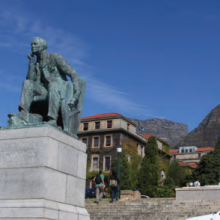
Cecil Rhodes monument, Cape Town, South Africa
The bronze statue of a seated Cecil Rhodes (1853-1902), on the campus of the University of Cape Town (UCT), was sculpted by Marion Walgate, one of the first white female sculptors in South Africa. Walgate had earlier made a bust of Rhodes, a mining magnate and arch advocate of British imperialism, for the colonial government of Southern Rhodesia (now Zimbabwe).

Christopher Columbus monument removal, Buenos Aires, Argentina
The Monument to Christopher Columbus (1451?-1506), located in a plaza in front of the Casa Rosada government palace, was inaugurated in 1921.

Christopher Columbus monument, Buenos Aires, Argentina
The Monument to Christopher Columbus (1451?-1506), located in a plaza in front of the Casa Rosada government palace, was inaugurated in 1921. It was a gift from the Italian-Argentinian community in response to a solicitation for proposals by a government commission in 1910 to commemorate independence from Spain, although the centennial emphasized Argentina’s European heritage.
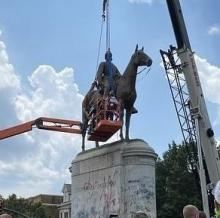
Stonewall Jackson monument removal, Richmond, Virginia, United States
The Stonewall Jackson Monument in Richmond, Virginia was erected in 1919 to honor Thomas ‘Stonewall’ Jackson (1824-1863), a Confederate general.
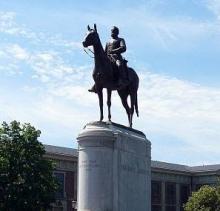
Stonewall Jackson monument, Richmond, Virginia, United States
The Stonewall Jackson Monument in Richmond, Virginia, was erected in 1919 to honor Thomas ‘Stonewall’ Jackson (1824-1863), a Confederate general. Jackson, a former instructor at the Virginia Military Institute (VMI), gained prominence, and his nickname, for leading a Confederate victory at the 1861 First Battle of Bull Run, Virginia. Jackson owned six slaves at the time of the war.
Excerpt from letter by Lady Mary Wortley
Travel writing by women can reveal a number of themes in world history. One useful example are the letters written by Lady Mary Wortley Montagu (1689-1786) who worked as a missionary in Turkey.
Excerpt from Travels in Africa
Imperialism is one of the most pertinent topics in relation to travel and exploration. By the end of the 19th century, the spread of European imperialism had made many areas of the world “safe” for women travelers. As a result the volume of women’s writing increased significantly, so there is a wide range of texts to choose from.
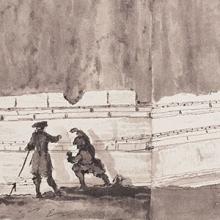
Salisbury Crags
Before about 1800, most people in the Christian world assumed that the earth was just a few thousand years old. But growing interest in fossils and strange geological formations made some people think the earth must actually be much older.

History of the Earth in a Cycle
Our sense of time has been extended into the deep past in the last two centuries or so, and particularly since the 1950s, when Willard Libby showed that you could use the breakdown of radioactive molecules such as Carbon-14 to date events thousands of years before there were any written documents.

Grid Map of Judicial Independence
Comparisons across world history can be productive if done with care. For example, the Constitute Project from the University of Texas-Austin has created a database of world constitutions that includes a feature for comparing various nations' constitutions to look for similarities and differences. The Constitute website lets users pin and export relevant passages for comparison.
Excerpt from the Asokavadana
The Asokavadana is a text written in Sanskrit that brings together oral traditions about Ashoka’s reign that did not die out when the Mauryan Empire collapsed, but spread throughout India
and beyond its borders. This section relates an incident from Ashoka’s life after he converted to Buddhism. Oral traditions about Ashoka grew up without reference to his actual edicts; people

Ashokan Pillar with a Single-Lion Capital at Vaishali, India
This is a photograph of one of the Ashokan pillars, topped with a single lion. (Other pillars are topped with three lions, an emblem that is now on the state seal of India and Indian coins,
or lions and the Buddhist wheel of law, an emblem reproduced on India’s flag.) Each of these pillars—more than thirty have been discovered—was transported hundreds of miles from
Selections from Ashoka, Rock and Pillar Edicts
The “rock and pillar edicts,” inscriptions that King Ashoka ordered carved in stone on large rocks in prominent places or on tall pillars that he had erected for this purpose, are the best record we have of Ashoka’s reign. The edicts are found in a number of different locations

From John Bartholomew, Literary and historical atlas of America
This unusual map appeared in a 1911 atlas of America by John George Bartholomew, a prestigious Scottish cartographer and geographer. In this map Bartholomew dramatized the provincialism of European cartography three centuries earlier. He did so by superimposing the Americas on a reconstruction of a 1474 map of Italian cartographer Paolo Toscanelli.

Cantino planisphere
The famous Cantino planisphere was made in 1502 by an anonymous Portuguese official at the request of Alberto Cantino, an Italian agent in Lisbon of Ercole d’Este, Duke of Ferrara. It is the earliest map showing the recent discoveries by the explorer Vasco da Gama, who, using a new portable version of astronomers’ astrolabe, charted Brazil, Newfoundland, Greenland, Africa, and India.

World map by Henricus Martellus
Henricus Martellus was a German geographer and cartographer who worked in the Italian city of Florence from 1480 to 1496. His book of 1490, Insularium Illustratum ("Illustrated Book of Islands"), in which this map appeared, was widely circulated for two reasons.

Early Modern Ottoman Carpet at the Walters Art Museum
This carpet is a specific type of carpet woven in the Islamic world called a sajjadah or prayer rug. Typically, these carpets will have one or more arches decorating its center field representing early mosque architecture or the mihrab a niche in a wall that directs the worshipper towards the holy site of Mecca.

Islamic Carpet made in Ottoman Turkey at The Metropolitan Museum of Art
This carpet is a specific type of carpet woven in the Islamic world called a sajjadah or prayer rug. Typically, these carpets will have one or more arches decorating its center field representing early mosque architecture or the mihrab a niche in a wall that directs the worshipper towards the holy site of Mecca.
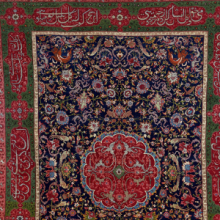
Islamic Carpet made in Safavid Iran
This carpet called the Qazvin Carpet (also known as the "Salting Carpet") was made in late-sixteenth century Safavid Iran likely in a royal atelier.
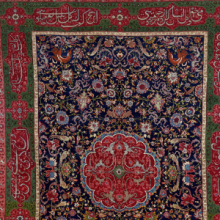
Islamic Carpets
These three carpets made in the period between the 16th and 18th centuries show two distinct types of carpets produced in the Islamic World for particular culture-specific uses.